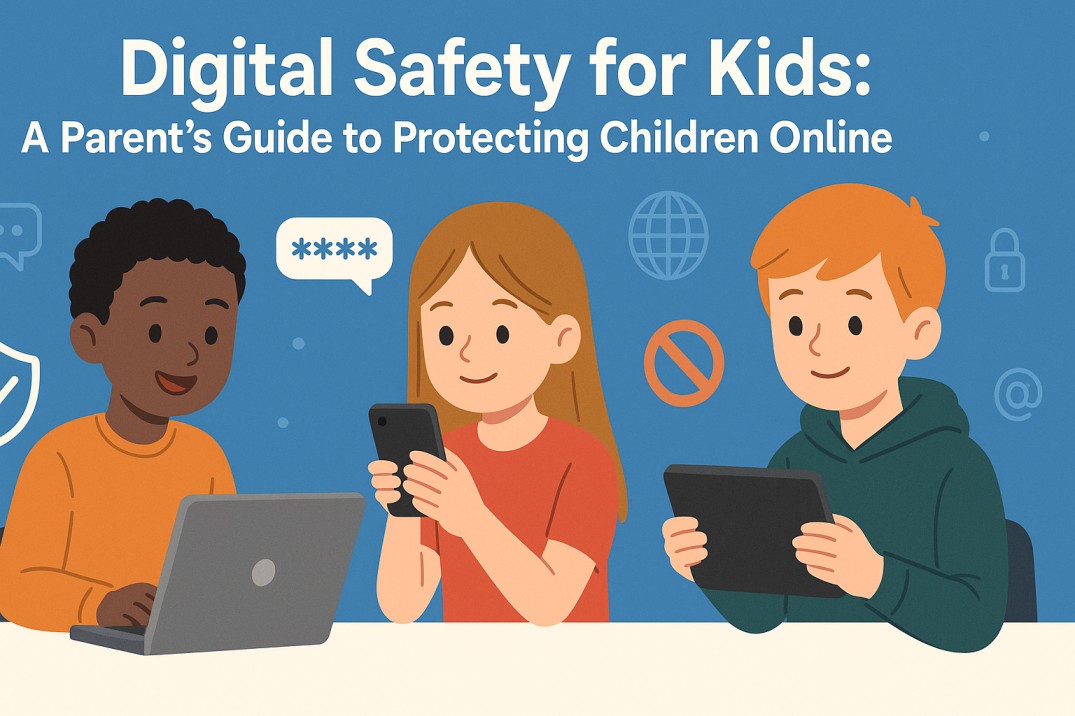Loading advertisement...
19-04-2025

In a world where children are growing up surrounded by technology, the internet plays a vital role in their education, entertainment, and social interactions. From educational apps to social media platforms, the digital world offers endless opportunities for learning and fun. However, with these benefits come significant risks, such as cyberbullying, inappropriate content, and online predators. As parents, it's essential to ensure that our children are not only learning how to navigate the online world but are also protected from its dangers. This blog offers practical advice on how to safeguard your children in the digital age.
In today’s digital era, children are spending increasing amounts of time online. From using smartphones and tablets for homework and research to playing games and watching videos, the internet has become an integral part of their lives. However, this exposure to the online world can lead to potential hazards. While technology can open doors to knowledge, it also requires responsible handling to prevent misuse or harm.
The internet is an expansive platform with a mix of content, both educational and harmful. Whether it’s explicit material, violent videos, or misleading information, children may encounter disturbing content unintentionally. It’s crucial to prevent them from stumbling upon such material during their online exploration.
What Parents Can Do:
Set up parental controls on devices and apps to block inappropriate content.
Use search filters on platforms like YouTube and Google.
Educate your children on identifying and avoiding harmful content.
Cyberbullying is a serious issue that affects many children, particularly in the realm of social media and gaming. The anonymity of the internet allows bullies to target others without face-to-face interaction, making it easier for harmful behaviors to go unnoticed.
What Parents Can Do:
Encourage open discussions about bullying and its impact.
Monitor your child’s social media and online activity.
Teach children how to block, report, and avoid cyberbullies.
Children often fail to realize the importance of keeping personal information private. Sharing details such as their location, full name, or even pictures can put them at risk of identity theft or exploitation.
What Parents Can Do:
Educate your children about the importance of privacy and the dangers of oversharing.
Set privacy settings on social media accounts and gaming platforms.
Talk about safe online behavior and discourage sharing personal details.
Unfortunately, online predators target children by pretending to be someone they are not. These predators can approach children on social media, gaming sites, and chat rooms, often engaging in manipulative conversations to build trust.
What Parents Can Do:
Regularly monitor online interactions and set boundaries for who they can interact with.
Teach your child to never meet strangers in person.
Set up parental monitoring software to track their online activity.
Most devices come with built-in parental controls that allow you to limit screen time, block harmful content, and track online activity. Parental control apps can give you an overview of your child’s online habits and allow you to set restrictions as needed.
Practical Tips:
Install apps like Norton Family, Qustodio, or Google Family Link to monitor and manage your child’s screen time and content.
Set filters on internet browsers and streaming platforms.
Enable features like geofencing and location tracking on mobile devices for added safety.
One of the most effective ways to protect your child is through education. Talk to your child about the potential dangers of the internet and ensure they understand how to act responsibly online.
Key Lessons to Teach:
The importance of using strong passwords and keeping them private.
The risks of clicking on suspicious links or downloading unknown files.
How to recognize and avoid online scams and phishing attempts.
To never share personal information or communicate with strangers online.
Establishing ground rules for screen time, app usage, and online behavior is vital. Setting boundaries helps children understand what is acceptable and what is not when it comes to their digital lives.
Suggestions for Setting Boundaries:
Limit daily screen time to ensure balance between online and offline activities.
Create a "device-free" zone or time, such as during meals or right before bedtime.
Establish a list of approved apps and websites for your child to use.
Creating an open line of communication is essential for your child’s online safety. If something upsetting or confusing happens online, they need to feel comfortable coming to you without fear of punishment.
Tips for Fostering Communication:
Regularly check in with your child about their online activities.
Encourage them to share any uncomfortable experiences, whether it's being bullied or encountering inappropriate content.
Listen actively and provide guidance without overreacting.
You don’t need to invade your child’s privacy, but regular monitoring of their online interactions and digital footprint can help ensure they are safe. It’s not about controlling every aspect of their digital life but staying vigilant about their safety.
Practical Steps:
Use monitoring tools to track browsing history and app usage.
Review their social media profiles and online friendships.
Check the privacy settings on their accounts regularly to ensure they’re up-to-date.
The internet can be an incredible resource for children, but it’s also important to acknowledge the risks that come with it. By actively engaging in your child’s digital life, setting clear boundaries, and educating them about online dangers, you can provide them with the tools they need to navigate the online world safely and responsibly.
Protecting your child in the digital world doesn’t mean restricting their access to technology; it means empowering them with knowledge and skills to stay safe while enjoying all the benefits the internet has to offer.
Call to Action:
Be proactive about your child’s online safety. Set up parental controls, foster open communication, and educate them about digital risks. With the right tools and guidance, you can help your child become a confident, safe digital citizen. Let’s work together to create a safer digital world for the next generation.
For More Updates,join us and stay connected!

